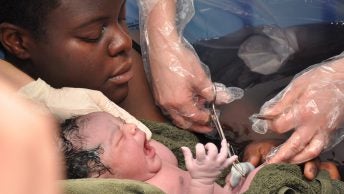I recently caught up with my friend Shivani Bhatia, the Maternal Health Coordinator at the Colorado Department of Public Health and Environment and Lead of Colorado’s Maternal Mortality Prevention Program and Maternal Mortality Review Committee (MMRC). At least 41 states and a handful of cities have established MMRCs, taking a critical step towards ensuring continuous quality improvement in maternal health and identifying areas for improvement. Shivani and I talked about the process itself, what the data reflect, how recommendations can translate into action, and how she personally copes with the grief process inherent in the review.

Jocie: Can you start by telling us a bit about what a maternal mortality review is?
Shivani: Sure. So the maternal mortality review process is an ethical system of what we call continuous quality improvement. And the point is that we can be self-reflective as a community and as a society to the health and safety of the pregnant and postpartum population. So we use it as a chance to identify underlying causes of death but also to make evidence-based recommendations to inform public health and clinical interventions to both reduce deaths and to improve wellness.
J: And can you walk me through what the process looks like?
S: We start with birth and death certificates to actually identify the roster of deaths that have happened in a year through Vital Statistics. Based on a list of everybody who could have experienced a maternal death, cases are identified by matching birth and death certificates – so a death certificate with a birth certificate within a year of that date. Or by an O-code on a death certificate, or by a pregnancy check-box that is on death certificates that a coroner would have filled out. From that list, we will go through and determine if there are any false positives that have been collected in that list, and then we will start by looking at who are the people and what are the cases of the people who have died and we start collecting information on those people.
We start with death certificates and then request medical records, autopsy records, police records, prenatal care records, everything we can to build up the whole picture of what happened to this person, what did their life look like, what did their death look like, and build a case story. So there are hundreds of hours that go into just building that story, that case narrative, the whole process. And next we have an internal review to make sure we have a complete story, as complete as we are going to get and we mark anything that might be missing, and then the fully de-identified case narrative will go to the full Maternal Mortality Review Committee. That committee has been about 20 or so professionals. We are onboarding new people onto the review committee in a couple of weeks, and so now it’s about 30 representatives from around the state – all different clinical and public health professions, everything from mental health, substance misuse, addiction medicine, family practice, midwifery, nursing, maternal-fetal medicine, obstetrics and gynecology, public health, suicide prevention folks, and all of those lenses. We also are onboarding a few people with lived experience to serve on the committee. So then the committee reviews each case story of what happened and we walk through the CDC’s committee decision form. It’s standardized: what actually happened, what was the underlying cause of death, was this a pregnancy-related death or not, was it a preventable death, what are the factors that contributed to the death, what are the recommendations that come out of it. Everything is completely deidentified by the time it gets to committee review so it can be as unbiased as possible, obviously understanding that we all come with different biases that will inform the review no matter what.
So that’s the review process of an individual case. From there, we do an aggregate quantitative analysis to understand demographics, causes of death, and inequities. What we are working on now is we’re going to be doing a qualitative analysis of all of the recommendations that come out of the process – both what could have been done differently and the wishlist of what we could do for health and wellness in general – and running a prioritization process. We’ll put together a list of recommendations and start to think about stakeholder engagement and how to actually make public health, policy, clinical quality improvement, and other programmatic recommendations. So that is yet to come, we’re building that out.
J: That’s so exciting. So that’s a new phase of your work?
S: Yes, Colorado has had a formal review committee since 1993, which has meant that we’re able to review cases but not implement recommendations more broadly. We have been funded under legislation that passed this last spring to support the review process: to collect better data, to staff it, to do more data analysis more frequently. And that legislation also enabled us to apply for the CDC grant that was funded through federal legislation at the end of 2018 – the ERASE Maternal Mortality program that just started. And the funding that we received through that program is going to support all of the prevention efforts, moving our recommendations forward.
J: That’s fantastic. I’m sure seeing the hard work that you’re putting into the reviews actually play into change will be incredible.
S: Yeah, it’s really exciting.
J: So when I started working in maternal child health, I was shocked that more than half of maternal deaths happen in the postpartum period, and I’d love to know if you’ve had any interesting findings regarding that and thoughts on strategies for prevention.
S: Oh yeah, absolutely. That’s very true in Colorado. The majority of deaths happen in the postpartum period, and they’re primarily late postpartum, which is further out than I think what the national story used to tell, the idea of people dying in childbirth. That’s often not what happens. So what we saw here in Colorado is that many of our deaths are behavioral health-related deaths, so the driving causes are suicide and accidental overdose. We are reviewing data from 2014-2016 right now but our last analysis covered deaths from 2008-2013, and some of that research was to analyze whether there were prescription drugs, recreational drugs, or a combination of both. Now, part of our review is also looking at the full picture of what resources people did or did not have access to, for mental health and for substance use.
In terms of actual prevention strategies, what we applied for with the grant and what we’re starting to implement is what I call the trifecta of opportunities to improve maternal wellness. The first arm is through perinatal clinical quality improvement, so implementing efforts such as patient safety bundles, improving clinical emergencies, that kind of thing. A lot of the safety bundles that exist address conditions like hemorrhage or preeclampsia, but there are also opportunities around reducing implicit biases and improving behavioral health care in a clinical setting. The second piece is all of our public health programming, and a lot of that is through Title V Maternal & Child Health, which is the primary vehicle for statewide public health programming. For the past five years, we’ve had priorities on pregnancy-related depression and on substance use disorder in the pregnant and postpartum period. We’ve been doing work such as provider education, systems building, resource allocation, Medicaid reimbursement for screening. There’s also been an extensive public awareness campaign in English and Spanish that we ran to reduce stigma around mental health. In the next five-year cycle of the MCH grant, we’re looking at the social and structural determinants of health. So how does systemic racism play into all of this? How does access to care and specifically high-quality and culturally competent care play into it? How does the built environment and economic security play into it? All of those big picture pieces, we’re going to be able to pay more attention to. And the third piece is what I’m really excited about, which is the community-led solutions. We know there are so many strengths and resources in communities already, and people have also been doing this work for so long, so how do we institutionally support the efforts that are already ongoing, and how do people who are already doing the work in their communities be a significant part of the solution? Those are the three avenues we’re looking at for prevention.
J: That’s great. And another trend that I think anyone who works in maternal health knows is that these issues disproportionately affect communities of color. How are you seeing that in your data and what do you see as solutions for reducing inequities?
S: Yeah, we see similar racial disparities as are seen nationally, where Black women are more likely to die of a maternal death. We also, especially in Colorado, have a significant rural population and we also see disparities rurally or people who live in poverty, all of the social determinants of health. And that to me is where the public health programming comes in and where the social and structural determinants of health come in. How are we paying attention to the health implications of economic security or systemic racism or access to care or housing or all of these other community-based, built-environment based issues? And then of course with the clinical improvement, a significant part is the question of racial bias in a provider setting and also in other informal care settings and other kinds of communities and spaces. So there are a lot of different pieces where it shows up and a lot of strategies for addressing it.
J: And, I don’t know the demographics of Colorado terribly well, but I can imagine that you don’t have a huge number of maternal deaths every year. How do you draw conclusions based on a relatively small sample size?
S: That’s a great question. So our numbers are low compared to other states. We are pretty fortunate, and we also recognize that every preventable death is one death too many. So with that, we need to aggregate quite a bit of time. So as I said earlier, we have analyzed data from 2008-2013 but with this influx of funding, we’re hoping to publish more frequently and keep on aggregating differently each time to make sure we’re capturing the whole picture. And I also think it’s important that we use it as one piece of our entire data puzzle, and we’re thinking about maternal health outcomes in general across all of our data. So it’s a combination of maternal mortality data, as well as robust PRAMS data. Also a new initiative that a number of people are working on right now is a new survey called Health eMoms, and it’s a longitudinal, mobile, online-based survey. There’s quite a bit more qualitative information in it which is exciting, so we’re able to take that information and have a different cohort from PRAMS data and put it together with PRAMS data and the maternal mortality data and other surveys and paint this entire picture of what does all of maternal wellness need, and not just maternal mortality. To speak to the point of Expecting More that survival is the floor. That’s our baseline – of course we want to prevent those deaths, and we also want to make sure that it’s leading to optimal health and the ability to choose what health means for you.
J: Finally, I think a lot of the people who are following along with Expecting More are in the maternal health field. And it’s a field that has great joys and also is really devastating at times. And your work is so focused on the latter. How does that personally affect you and how do you deal with it?
S: Ah, that’s a really good question. So I think the piece that I love about this work is that the ethic of the review is one that’s respectful and an opportunity for self-reflection as a community or as a society. It’s not meant to be punitive in any way, and part of why we respect confidentiality so much is to respect that everyone involved in that story is holding trauma. Of course it’s the person who died and it’s also that person’s family and entire community and everyone that they had interaction with. And it’s also the provider care team that took care of them and whatever other care that they sought. There are so many people that have been affected and are experiencing trauma from that death. To me it’s an important practice of self-reflection and of grief. We always have a moment of silence at the beginning of the review committees, and I cry over almost all of the cases. I think that grief process is really important. It’s an opportunity for us to grieve people who have died, to grieve that these are outcomes and inequities that are happening in our society. And to allow that to be the fire to do better and ensure that survival is not the floor. And there is so much more that we can do.
J: Yes, and I’m sure especially true with these upcoming opportunities in your work where you can follow up on recommendations.
S: Absolutely, yeah.
J: Well thank you so much for speaking with me, we really appreciate it and appreciate the work that you are doing. So thank you.
S: Thank you!

Shivani Bhatia is the Maternal Health Coordinator at the Colorado Department of Public Health and Environment. She leads Colorado’s Maternal Mortality Prevention Program and supports Maternal & Child Health work on maternal mental health, low-risk cesarean section rates, and infant mortality prevention. She has worked in maternal and infant health in Boston, New York City, and Mumbai, India. Shivani holds an MPH in Population and Family Health from Columbia University’s Mailman School of Public Health and a BA in Neuroscience and Music from Dartmouth College. When she’s not advocating for sexual & reproductive justice, health, and rights, she teaches yoga and volunteers as a full spectrum doula.
For more information about MMRCs, check out the following sources:
- Propublica: Here’s one issue red and blue states agree on: preventing deaths of expectant and new mothers
- CDC: Report from nine Maternal Mortality Review Committees
- Review to Action: Working together to prevent maternal mortality


